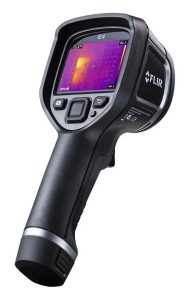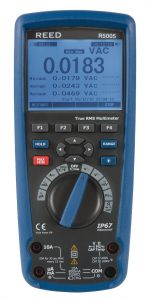Cost Competitiveness, Newest Technologies Make Thermal Imaging Accessible to Wide Range of Industries
 Infrared Thermography (IRT) or Thermal Imaging Camera use in commercial and industrial applications is gaining popularity as the Flir E4 Thermal Imaging Camera.jpgtechnology, portability and compact designs of the devices improve, making them more cost competitive, and an optimal choice over traditional single point IRT counterparts.
Infrared Thermography (IRT) or Thermal Imaging Camera use in commercial and industrial applications is gaining popularity as the Flir E4 Thermal Imaging Camera.jpgtechnology, portability and compact designs of the devices improve, making them more cost competitive, and an optimal choice over traditional single point IRT counterparts.
Home, Building Inspection
Home and building inspectors are finding Thermal Imaging Cameras a useful tool for identifying thermal patterns to diagnose a multitude of building conditions like improper insulation, leaks, moisture presence, heat loss, structural flaws and overloaded circuitry. In combination with thermal imagers, other products are useful in home and building inspections and problem detection, including thermo-hygrometers, moisture meters, air velocity meters, video inspection scopes and indoor air quality meters.
Electrical and Mechanical Inspection, Predictive Maintenance
Thermal Imaging is especially beneficial in preventing risks and failures in electrical and mechanical applications for plant maintenance programs. Thermal Imagers are non-contact testing instruments that scan, visualize and analyze temperatures of mechanical equipment, trouble-shoot multilayer electronic and circuit boards, and electrical systems quickly and accurately. Routine electrical inspections using Thermal Imaging cameras can help prevent unexpected outages and reduce risk and insurance liability for manufacturers and industrial plants. Predictive maintenance programs also benefit from the use of vibration meters, tachometers, stroboscopes, clamp meters and multimeters for electrical and mechanical inspections.
HVAC, Plumbing
 HVAC and plumbing professionals are finding thermal imagers useful in looking at surface temperatures to help evaluate building conditions including electrical, mechanical, plumbing and HVAC systems by monitoring air circulation and air leakage, moisture accumulation, temperature distribution issues, leaking or blocked pipes. Thermal Imaging is beneficial in HVAC and plumbing because it takes a broader scan of the building by assessing the heat transfer from the surface temperature of walls and floors and provides valuable information for what the human eye can’t see. Moisture meters, video inspection scopes, clamp meters, multimeters, thermo-hygrometers and indoor air quality meters are also effective in detecting and preventing HVAC system malfunctions.
HVAC and plumbing professionals are finding thermal imagers useful in looking at surface temperatures to help evaluate building conditions including electrical, mechanical, plumbing and HVAC systems by monitoring air circulation and air leakage, moisture accumulation, temperature distribution issues, leaking or blocked pipes. Thermal Imaging is beneficial in HVAC and plumbing because it takes a broader scan of the building by assessing the heat transfer from the surface temperature of walls and floors and provides valuable information for what the human eye can’t see. Moisture meters, video inspection scopes, clamp meters, multimeters, thermo-hygrometers and indoor air quality meters are also effective in detecting and preventing HVAC system malfunctions.
Equine, Veterinary
Thermal Imaging Cameras are proving a valuable diagnostic tool in the prevention of injuries and rehabilitation in animals. Thermography is a non-invasive, non-contact technique using a Thermal Imaging camera to provide a visual inspection of the surface temperature of an animal’s body, which can help a practitioner diagnose and treat the problem. Thermal Imaging cameras can help detect back and joint issues, degenerative hoof conditions and other serious stresses in horses and other animals.
Road Construction
A significant road construction-related problem, known as thermal segregation of hot mix asphalt (HMA) can sometimes occur during construction reducing compaction, affecting the quality of the pavement by reducing the pavement density, creating air voids, increasing permeability and decreasing shear strength, leading to diminished life and costly repavement. Thermal Imaging Cameras have proven effective in identifying possible thermal segregation during construction by detecting temperature gaps in sections of laid pavement.
Workplace Ergonomics
Safety managers could benefit by including Thermal Imaging into their wellness programs to help decrease possible workplace stressors like indoor air quality and injuries. Thermal Imaging cameras can establish baseline measurements and assess employees at risk for work-related injuries as well as identify work-related musculoskeletal disorders, all to help reduce costs associated with workers’ compensation.
Thermal Imaging Cameras have come a long way since their original inception, and over the past few years, improved manufacturing, advancement in technologies and lower cost to produce, have made them more accessible for a wider range of industries and applications. Today’s IRT cameras are three times more sensitive, five times faster, and capable of capturing video, not just photos, and are generally some modes less than $4,000, compared to early models, which neared the $20,000 price range. They make testing and evaluating easier than traditional methods with increased accuracy because they’re non-invasive, non-contact, objective and lightweight.
The new REED R2100 Thermal Imager features color TFT LCD capacitive touch screen, high thermal sensitivity, built-in laser and visible light digital camera, 7.5mm lens, 20x continuous zoom, just to name a few, and is suitable for all the applications listed here, and many more. Let us know how you use your REED Thermal Imager.
Source: Reed Instruments
